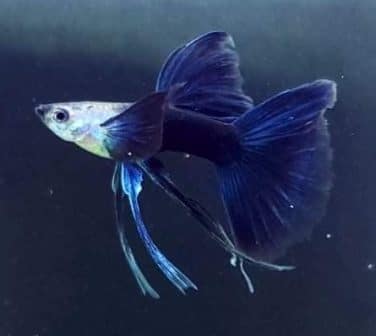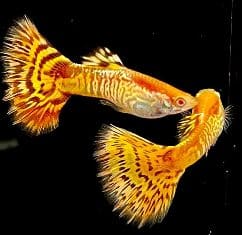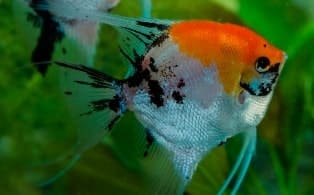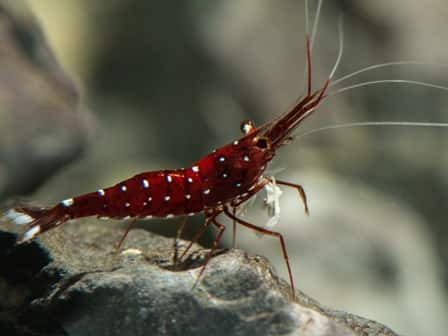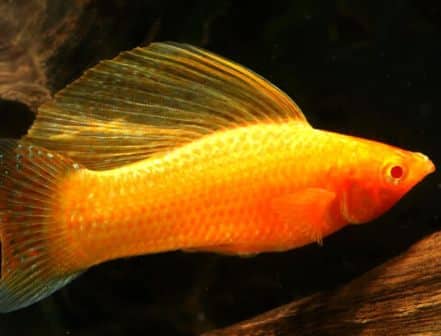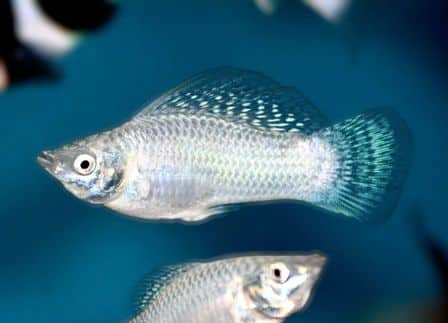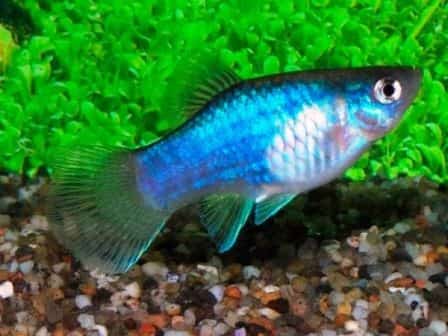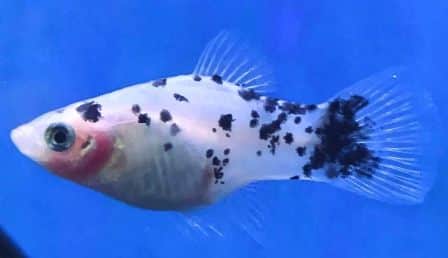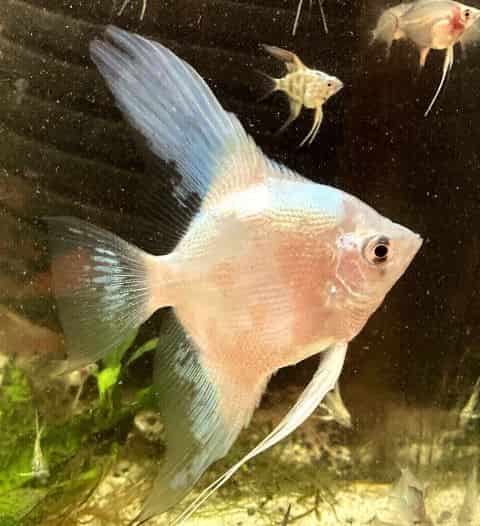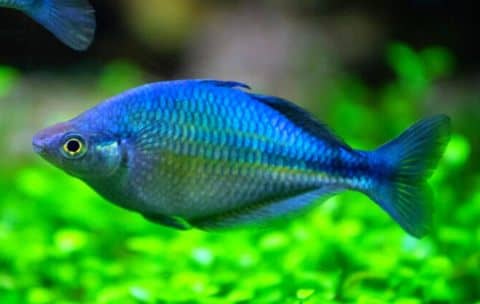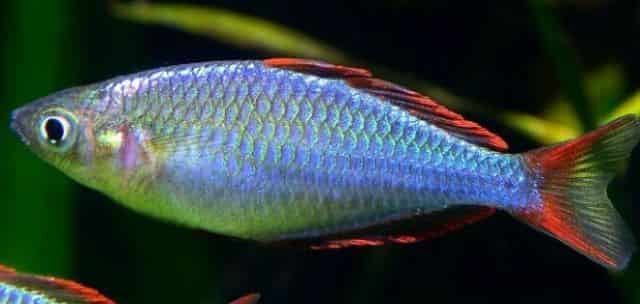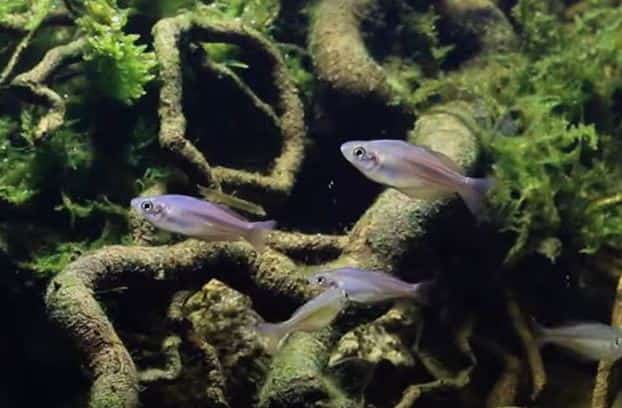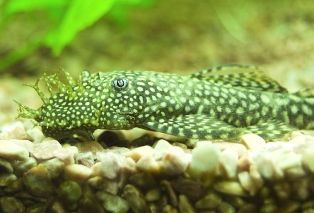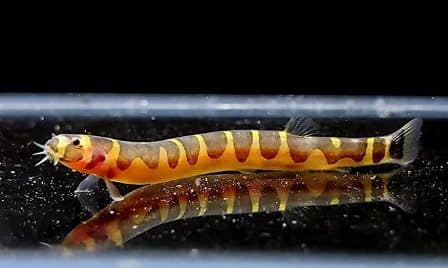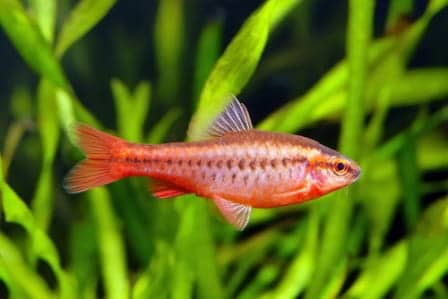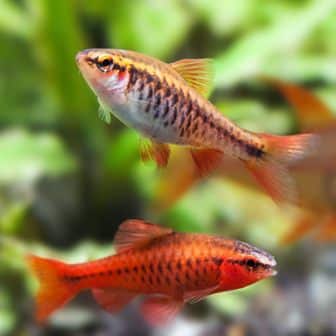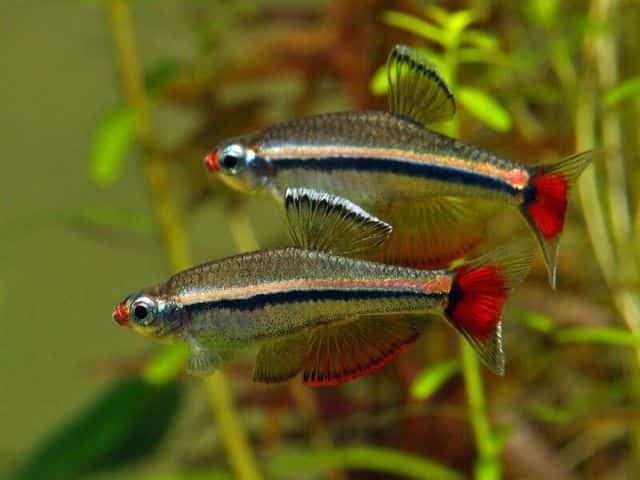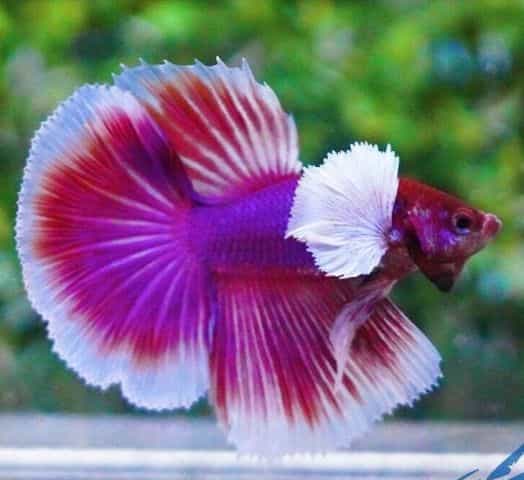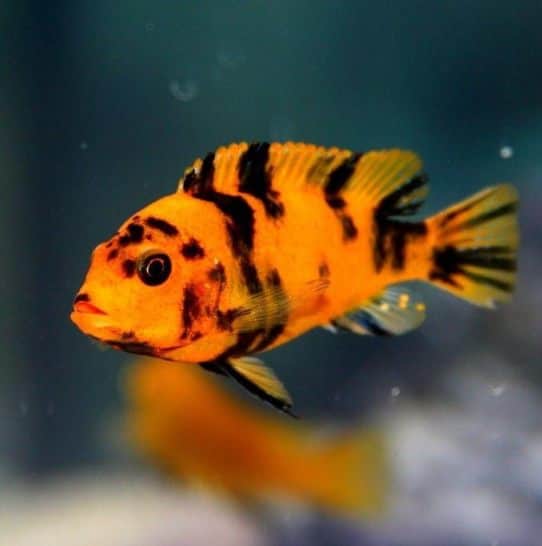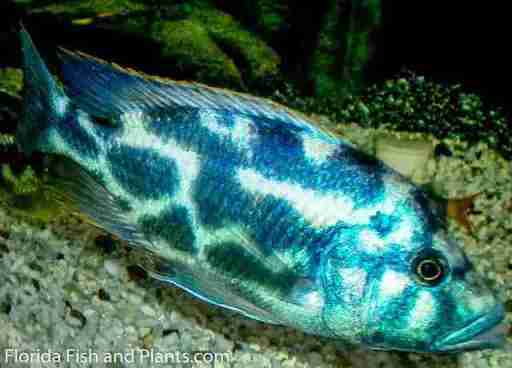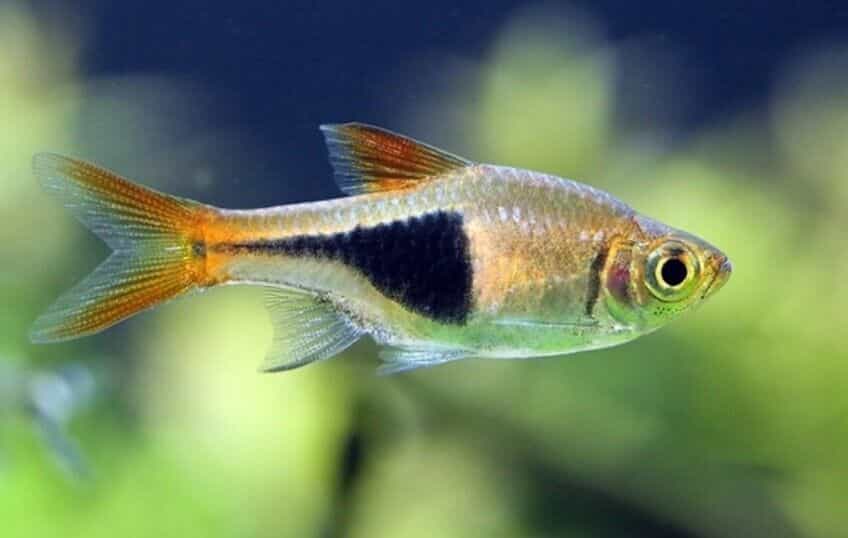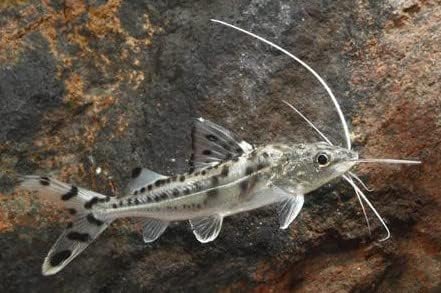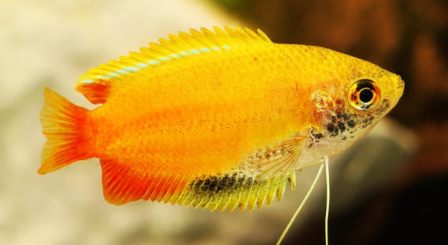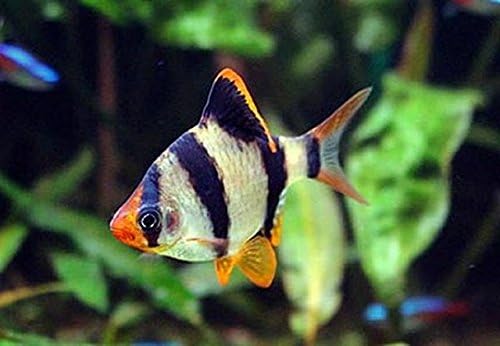The 20 Best Starter Aquarium Fish For Beginners (With Pictures)

Are you a beginner aquarist? Are you going to start an aquarium? If yes, and if this is your first-ever aquarium, then you’re probably wondering what fish to buy. In this article, I will explore a list of the 20 best starter aquarium fish for beginners. Fish that you will love and that are easy to care for. So, let’s start and explore some beautiful fish for the beginner aquarists.
Easy Fish #1: Guppies
Poecilia reticulata
Very easy to keep
Guppies (scientific name: Poecilia reticulata) could easily be the most popular freshwater aquarium fish. Also known as rainbow fish or million fish, guppies are peaceful and gentle. They get along well with just about any fish similar in size to themselves. A typical male guppy will grow to about one inch, and the female will grow to maybe two inches. Highly bred guppies will grow somewhat larger. When well cared for, guppies might live up to 2 years.
A great starter aquarium fish, guppies are native to the Caribbean islands. In their natural habitat, they prefer smaller pools and streams rather than deep or large bodies of water or fast-running rivers.
Each guppy should have at least five gallons of aquarium space. They prefer water temperatures of 75°F to 82°F and a ph level typical for a tropical aquarium.
Feeding Guppies: Number one on my list of the 20 best starter aquarium fish for beginners. Guppies are omnivores, which means that guppies can eat both animal and plant matter. They will eat just about anything you give them, including fish flakes and tablets, frozen foods, veggies, and live foods like brine shrimp.
Breeding Guppies: Guppies breed like crazy. You don’t need to do a thing except purchase a female guppy. A female that has given birth in the past may give birth to as many as 80 young every month. Guppies give birth to fully formed and free-swimming young. Predatory fish, like Angelfish, can control guppy populations in the aquarium.
Colors and Types: There is a lot of color variations in guppies including red, blue, yellow, white, orange, black and “metal” colors (see the metal colored guppy pictured above). Wild guppies are generally a very plain tan with a dot or two of black. Domestically kept guppies have been selectively bred for dramatic colors and large tail fins. Male guppies with tail fins larger than their body are now common.
Readily available
Image above: Gold Sailfin Molly
Image Above: Silver Molly
Image provided by lrrandaquatics eBay seller. To view this fish tap here.
If any fish stands for Best Aquarium Fish For beginners
The biggest issue is trying to keep from having too many mollies because of how easy they breed in a home aquarium.
Mollies (scientific name: Poecilia Sphenops) are excellent fish for beginners due to how incredibly hardy they are. They are gentle and are unlikely to bully their tank mates. They’re effortless to breed, and their care is easy.
Here’s a little-known remarkable fact: Mollies can survive in both saltwater and freshwater aquariums. Mollies are now being bred and raised in saltwater tanks for sale to saltwater aquarists.
Mollies are best kept in an aquarium 20 gallons in size or larger with a satisfactory filtration system. They prefer typical tropical fish temperatures of 72 to 78℉. They accept a wide PH range.
Feeding: Mollies are omnivorous, meaning they require a diet of both animal and plant-based foods. Since they are omnivorous, they can eat pretty much anything that you offer to them.
You can feed the mollies any combination of high-quality pellets or flake food, frozen foods, fresh or cooked vegetables, and algae wafers. They are excellent beggars, so be careful not to overfeed.
Breeding: Mollies are livebearers, which means they give birth to fully developed, free swimming young. Because mollies breed very easily in your home aquarium you may soon have many more than your tank can handle. This is easily remedied by keeping mollies with predatory fish like angelfish or other cichlids.
Colors and Types: Mollies are available in a wide range of colors including orange, gold, black, red, green, white and yellow. Shapes include balloon mollies, sailfin mollies, Lyretail and traditional mollies.
Availability: Readily available where aquarium fish are sold.
Female Blue Platy
Image provided by the Amazon store, “Aquatic Heaven.“
You can purchase this platy by tapping here.
If sold, you can see all Aquatic Heaven’s Platies by tapping here.
Image below is also from Aquatic Heaven and can be purchased by tapping here.
Salt and Pepper Platy
Platies (Scientific name: xiphophorus maculatus) are another “live-bearing” freshwater fish. These small fish never grow more than about 3 inches long and live about three to five years. They have various distinguishing traits that make them a favorite fish to aquarists, including being non-aggressive and peaceful. For sure a contender for top 20 best aquarium fish for beginners.
Each platy you keep should have at least 13-gallons of tank space. Change 25% or more of your aquarium water every two weeks for happy, healthy fish,. Platies are tropical fish and prefer water temperatures 72°F to 78°F with a PH of 7.0 to 8.3.
Feeding: Platies are omnivores meaning they need a mix of veggies and protein-based foods. Of course, they will probably accept anything edible that you throw in their tank. You can feed your platies high-quality pellet food, commercial flake supplemented with fresh vegetables, brine shrimp and spirulina algae tablets, and frozen fish foods.
Breeding: As mentioned, platies are a live-bearing species. The female gives birth to fully formed fry (fry = young fish) rather than laying eggs. Platies generally give birth to around 30 fry each month. All of these baby fish mean that, for each female platy, if all of the babies survive, you will have 360+ platies in your tank at the end of one year. As mentioned earlier, with mollies, you’ll want to have at least one predatory fish in with the platies. Angelfish are an excellent choice as they have the same temperament as platies and will help keep your platy population explosion under control.
Colors and Types: Platies are considered one of the more colorful freshwater fish. Common colors include blue, red, orange, and yellow, with some fish mixing these colors. Platies are known by various names related to their colors, including Redtail Platy, Hawaii platy, Yellowtail platy, Marigold platy, Rainbow Platy, and Sunset Platy.
Availability: Readily available where aquarium fish are sold.
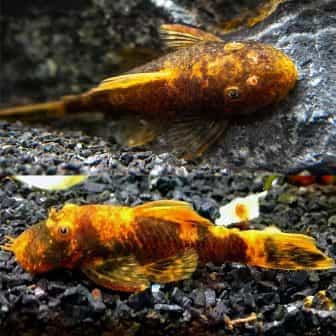
Calico Bristlenose Plecostomus
Top picture: Female Calico Pleco. Bottom picture male Calico Pleco.
Images provided by Aquatic Heavens, Amazon.
To view or buy a Calico Pleco from Aquatic Heavens, tap here.
If the calico pleco is sold out, other plecostomus fish can be viewed here.
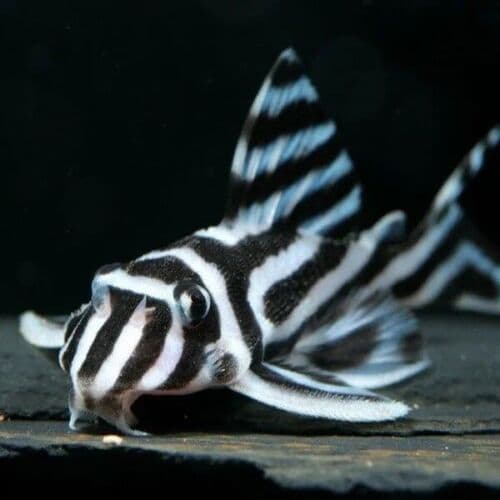
Image above: captive bred Zebra Plecostomus
Picture provided by Troyanko, an eBay seller.
You can put one of these super cute plecos in your aquarium by tapping here.
If they are sold out you can see more Zebra Plecos here.
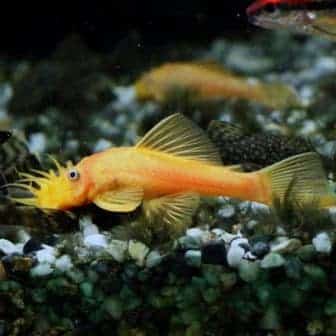
Image above: Captive bred Albino Bristlenose (male)
Picture provided by Aquatic Heavens an Amazon seller.
You can put one of these super cute plecos in your aquarium by tapping here.
If they are sold out you can see more Plecos here.
How to care for your pleco and a warning…
Having kept a couple of different types of Plecostomus, here are a few things I know personally:
Some Plecos get BIG. Not only big but ugly, in my opinion. Other aquarists think this too. In Florida, Plecostomus fish have been released in the wild by aquarists that no longer want the big, ugly fish in their tanks. They have become an invasive fish taking over waterways and lakes, out completing the native Florida fish.
To avoid the “big and ugly” problem, buying the smaller (often more expensive) specialty plecos is a good idea.
Unfortunately, smaller plecos can be pretty expensive. In searching for Zebra plecos (adult size three to four inches), I found that the average price is $300. A less expensive smaller Plecostomus to try is the Bristle Nose Plecostomus. I have a Bristle Nose (a female) in my 30-gallon aquarium and can recommend them. My female Bristlenose Pleco cost about $20.
Not all plecos are herbivores. My Bristle Nose pleco turns up its bristly nose at veggies and algae wafers but loves frozen protein based foods like frozen brine shrimp.
Plecostomus (scientific name: Hypostomus Plecostomus) is a popular fish for the freshwater aquarium. This fish is sometimes off-handedly called a “garbage disposal” due to their cleanup at the bottom and sides of the fish aquarium.
Plecostomus species are native to South America, although some Plecostomus species can be found in the Central American countries of Costa Rica and Panama. In their natural habitat, most pleco’s live in fast running, shallow rivers and streams.
Unless you buy a small pleco like I recommend, plecostomus should be kept in a lightly stocked aquarium of 30 gallons or more. You don’t want too many other fish in the tank as plecos are messy and poop a lot! You’ll want a large and robust filtration system to help control their mess and waste. You’ll also want to change at least 20% of the water every week. When I kept plecos, I would change 50% of the water weekly.
Plecostomus fish prefers water temperature to be 72°F to 84°F and water PH to be between 7.0 and 8.0.
Temperament: The behavior of Plecostomus fish in an aquarium is they are usually aggressive towards other Plecos but relatively gentle with other tank mates. They will, however, go after any fish eggs from any egg-laying spawning pairs of fish.
Be aware: I’ve watched Plecos I’ve owned latch on to other fish and chew on their skin, causing sores on the fish getting chewed on.
Breeding: Beginners and experts should forget about breeding Plecostomus in their freshwater aquariums. They are commonly bred in large ponds. They are egg layers, and in the wild, they usually spawn in caves and lay a large volume of eggs on flat surfaces. The male then guards the cave until the eggs hatch.
Interesting fact: Bristle Nose Plecostomus will breed in an aquarium if they are well cared for, if you have a male and female, and if they have a cave to lay eggs in. The eggs freely turn into fry that the parents protect. If protected from predators, you will soon have a tank full of cute little plecos.
Colors and types: They can be found in greys (most common), albino, white striped, and gold dots. Some of the species of Plecostomus available for your aquarium are Sailfin (Big and Ugly), Royal, Zebra, Bristlenose, Clown, Gold Nugget, and Snowball.
Plecos live to be 10 or 15 years old and may grow to 12 inches (think, Big and Ugly) in length when kept in an aquarium.
They seem to enjoy chewing on wood, so keeping driftwood in the aquarium with them is recommended.
Feeding: Most Plecostomus are known as the “algae eaters,” which means they are herbivorous. Some Plecostomus are carnivorous, and they will eat invertebrates, crustaceans, and smaller fish.
Plecostomus fish will eat just about any food that falls to the bottom of the tank but love chewing on algae tablets. They will eat any veggie you feed them, including shelled peas, lettuce, cucumbers, spinach, and zucchini. Cooking the veggies will help them sink to the bottom of the tank where your Plecostomus can find them.
Availability: Common colors readily available where aquarium fish are sold. Uniquely colored or unusual plecos will probably need to be purchased online.
Easy Fish #5. Angelfish
Pterophyllum scalare – Most common. There are four (possibly five) distint species of Angelfish.
Very easy to keep
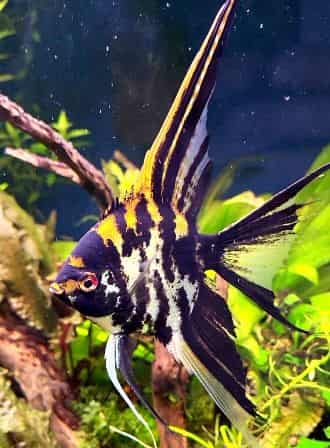
Image above: Black Marble Veil Angelfish
Angelfish image provided by Kizzys Fish Room, an eBay store.
Image above: Blue Pinoy Paraiba x Ghost Angelfish – Proven Breeding Pair $200
Angelfish image provided by jzt6j-59, an eBay seller.
The angelfish (Pterophyllum scalare) is another popular fish in the aquarium hobby. So popular that it has to be in the running for the best aqauarium fish for beginners. Angelfish are admired due to their beautiful swimming behavior and how easy they are to care for. They would be a lovely addition to your large community aquarium.
Angelfish species originated from the Orinoco Basin, Amazon Basin, and the various rivers of the Guiana Shield in tropical South America. Naturally, these fish are found in slow-running water.
For angelfish, 30 gallons or larger tank size is recommended per fish. Keep your aquarium water filtered and change 90 % of your aquarium water weekly. The preferred water pH for Angelfish is 6.5 to 6.9. Preferred water temperatures should be between 76°F to 82°F.
Temperament: Angelfish behavior is usually gentle, but they can become aggressive and territorial when a pair is spawning.
Life Span: They live about ten years when well cared for.
Feeding: Angelfish are omnivorous and will eat just about any fish food you provide them. They’ll eat flakes, small shrimp, food granules, small food pellets, and frozen food like bloodworms and brine shrimp.
Breeding: Mature angelfish create monogamous pairs if there is a male and female in your tank. Angelfish eggs are laid on a vertical surface such as a flat leaf, wood, or even aquarium glass. When the eggs hatch, angelfish fry will remain where laid until they are free-swimming. To ensure the pair don’t eat the eggs do 3 things: 1) give them a tank to themselves 2) give them low level lighting 3) ensure the ph of the water is 6.7 or lower. Miss any of these three and most assuredly they will eat their eggs.
Colors and types: Angelfish are available in different colors such as yellow, golden, platinum black, silver, etc. Angelfish are available in many color variations, such as silver, koi, zebra, black lace, golden, dusky, blushing marble, half black, and golden marble angelfish.
Wild bred angelfish can be purchased and are available in silver color with dark or black vertical stripes.
Availability: Readily available where aquarium fish are sold.
Easy Fish #6. Corydora (Cory) Catfish
Medium to challenging easy
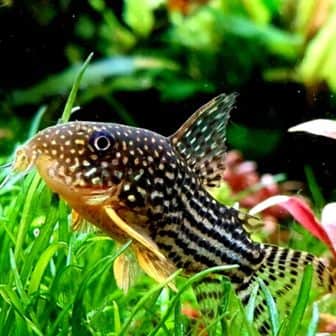
Image above: Sterbai Cory Catfish
Image provided by Neat & Tidy an Amazon seller.
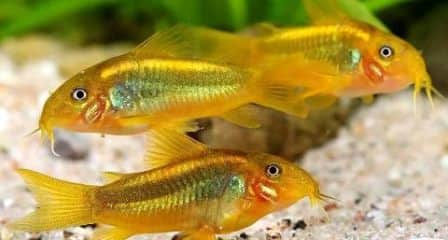
Image above: Gold Laser Cory
Image provided by Neat & Tidy an Amazon seller.
Cory Catfish are also called Cory Fish, Cory cats, and Corydoras catfish. These fish are also called armored catfish.
They would win the award for cutest fish, if there was a contest.
Most aquarists love this fish because of its unique characteristics, gentle nature, and mild temperament. This makes them perfect for a beginners freshwater aquarium.
Various countries of South America provide native habitat for Corys, where they usually inhabit small rivers and streams.. They usually inhabit small rivers and streams.
Cory Catfish are small enough that you can keep them in a 10-gallon aquarium. They prefer to be kept in schools, so a larger tank is more appropriate.
Cory Cats prefer a water PH of between 6.8-8.0 and water temperatures typical of tropical fish.
Temperament: Cory cats are peaceful and non-aggressive.
Feeding: Cory catfish are omnivores, and they can eat both plant and animal matter. Shrimp pellets, feeder tablets, algae rounds, tropical granules, and live foods are excellent choices for Cory cats.
Breeding: Cory catfish are egg depositors. These catfish breed in groups, such as two males to one female. The breeding tank should have many live or fake plants. The keeper of Cory cats should cover bottom of the breeding tanks with sand or fine gravel.
Colors and types: Cory’s are available in different colors such as green, black, albino, and bronze. Wikipedia shows 161 different variations of Cory Catfish.
Availability: Readily available where aquarium fish are sold.
Another great starter aquarium fish for beginners are rainbowfish. Rainbowfish are gorgeous fish that will make your aquarium fascinating to visitors.
Note: Honestly I have never purchased a rainbow fish. I guess it is time to “try them out.”
Rainbowfish (Melanotaeniidae) inhabit eastern and northern Australia, the islands of Raja Ampat in Indonesia, the islands of Cenderawasih Bay, and New Guinea.
Rainbowfishes natural habitats are large, slow-moving bodies of water, including lakes, rivers, and swamps.
30 gallons or larger tank per fish is suitable. Don’t over stock. Proper water temperature for rainbowfish is between 74 and 78°F, while the preferred pH would be between 7.0 to 8.0.
Temperament: Rainbowfish are peaceful unless breeding. If they are breeding and you have more than one male rainbowfish in your aquarium, the males will fight in their efforts to mate with the female.
Life Span And Size: The rainbowfish lifespan is about 6 to 8 years. They will grow out to be between two and four inches. Assume 4 inches and make the choice of how many to buy based on that.
Feeding: Rainbowfish are omnivorous. They will eat floating vegetation, cooked and canned veggies, protein-based flakes, tablets, live foods, and more.
Breeding: Rainbowfish are very easy to breed. They are egg scatterers. When you want to reproduce this fish, raise the breeding tank temperature by 2 or 3 degrees. This will increase the spawning activity. These fish court in the early morning and then spawn at the first light. The adults should be removed after the eggs have been laid.
Give appropriate food to baby fish after they start swimming freely.
Colors and types: Rainbowfish colors include red, yellow, silver, blue, and orange. A few of the different kinds of Rainbowfish are Australian Rainbowfish, Boesemani, Axelrod, Celebes, Praecox, Threadfin, Red Irian, Pseudomugil, and Turquoise.
Availability: Often, but not always available where you buy aquarium fish.
Easy Fish #8. Goldfish
Ease care: medium to challenging easy, due to needing cool water and a clean tank and how long they live.
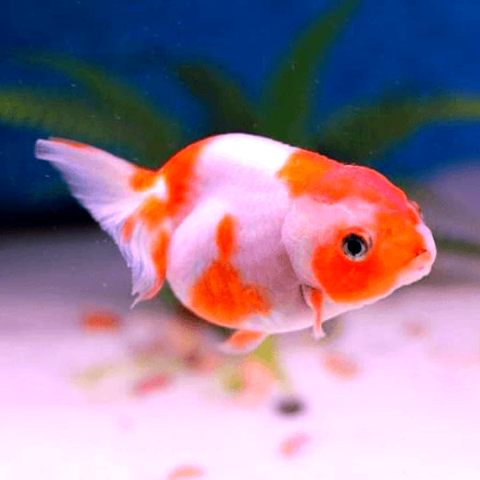
Ranchu Goldfish
Image provided by Aquatic Heaven, An Amazon Seller
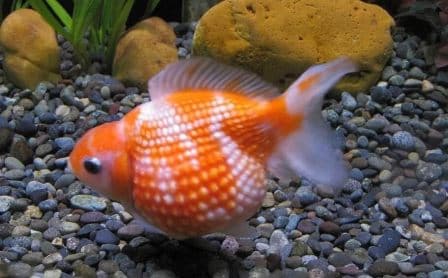
Ranchu Goldfish
Image provided by Neat and Tidy Fish Store, An Amazon Seller
Super Important Fact About Goldfish:
They must be kept in cool water. Do not put them in with your tropical fish. They will slowly die from that environment. Please be kind.
____________________________
The goldfish (Carassius Auratus) is a freshwater fish that belong to the fish family of Cyprinidae. They are one of the most exciting fish for your aquarium. Goldfish species have been bred to extremes. Varieties include bubble eyes, brainheads, super fat bodies, and more.
The goldfish is native to East Asia. Natural goldfish habitats are slow streams and lakes.
Goldfish get big (six to eight inches at maturity)! Never keep a goldfish in a goldfish bowl. That isn’t kind. One goldfish with very few, if any, tank mates to a 55-gallon aquarium is about right. Their preferred water temperature is 65 to 68°F and an unheated tank. Because of the desired temperature, tropical fish should not be kept with goldfish because of temperature differences.
Preferred PH for goldfish is between 7.2 and 7.6.
Temperament: Goldfish are very relaxed and gentle. They want clean water and lots of food to be happy and peaceful.
Life Span: A healthy goldfish who is kept in a clean, cool environment will live 15 to 20+ years.
Feeding: You can feed your goldfish canned and boiled vegetables such as carrots, peas, and zucchini. You can also feed them bloodworms, shrimp, and other live foods. They are always hungry, so they will eat just about any fish food they are given.
Breeding: Place the female and male goldfish within the same tank. An outdoor plastic swimming pool works much better than trying to breed them in an aquarium. Then you must wait for the female to drop her eggs and for the male to fertilize them. When the eggs are fertilized, transfer both adult goldfish into a different tank, so they don’t eat the eggs. The eggs will hatch out in four to seven days, with the fry becoming free-swimming at hatching.
Colors and type: Goldfish exist in different colors such as yellow, white, orange, calico, black, and red. There are many variations such as wakin, veiltail, comet, fantail, shubunkin, and much more.
Easy Fish #9. Bristlenose Plecostomus
Also know as bushynose plecostomus
Ease care: very easy
Calico Bristlenose Plecostomus
Top picture: Female Calico Pleco. Bottom picture male Calico Pleco.
Images provided by Aquatic Heavens, Amazon.
To view or buy a Calico Pleco from Aquatic Heavens, tap here.
If the calico pleco is sold out, other plecostomus fish can be viewed here.

Image above: Captive bred Albino Bristlenose (male)
Picture provided by Aquatic Heavens an Amazon seller.
You can put one of these super cute plecos in your aquarium by tapping here.
If they are sold out you can see more Plecos here.
The Bristlenose Plecostomus, also known as bushy nose plecostomus, is a freshwater tropical fish that belongs to the family loricariidae.
This fish is native to Panama and South America. Bristlenose Plecostomus fish can be found in floodplains and river areas of the Amazon Basin.
These fish will grow to be between four inches and eight inches in length with five inches being common, so the minimum tank size needed would be 30+ gallons. (Side note: I have my single female Bristlenose in a 30 gallon along with four small tetras. I won’t be putting any more fish in that tank.) Preferred water temperature is 75 degrees to 80 degrees. Recommended pH for the Bristlenose Plecostomus is 6.5 to 7.5.
Temperament: Bristlenose Plecostomus are peaceful. Mine likes to hide only showing itself occasionally.
Life Span: This fish will live between 5 and 12 years.
Feeding: You can feed these fish vegetables such as peas, carrots, cabbage leaves, and cucumber. A mix of 15% protein and 85% plant matter is recommended.
Breeding: Bristlenose plecostomus are fairly easy to breed in a breeding aquarium. The pair will need an artificial or natural “cave” to lay eggs in. Once the eggs have been laid the female is done with her “duties” and should be removed from the breeding tank. The male bristlenose will guard the eggs until they hatch.
Colors and types: These fish are available in albino, black, brown, and grey. Most have white or gold colored dots covering their bodies.
Adult Male Bristlenose Plecostomus – Click Here to see this picture full size – opens in a new tab.
Availability: Occasionally available in pet stores. Although I have purchased one in a pet store, at this point I would buy online. I also would make sure I have an aquarium large enough and buy at least three to give me a better chance of obtaining a male (males when full grown will have bristles. Females don’t).
Kuhli Loach
Image provided by Aquatic Heavens, an Amazon seller.
To buy this Kuhli Loach (or one of its brothers, sisters, or cousins) tap here.
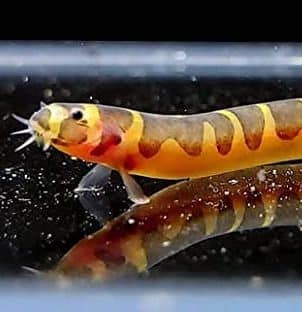
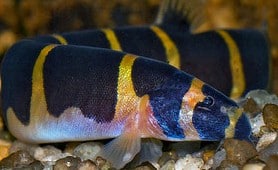
This Kuhli Loach photo is provided courtesy of AJC1 and is a creative commons picture.
The kuhli-loach is an unusual-looking fish appearing more like an eel than a fish. It is timid and nocturnal. It will hide using the aquarium ornaments or by digging into the substrate.
Kuhli loach (Pangio Kuhlii) is also known as leopard loach, coolie loach, or cinnamon loach.
It is native to the Malay Peninsula and Indonesia, where they inhabit slow-running waters and forest streams.
10 facts about Kuhli Loach fish:
1. Size: Kuhli Loach will grow to be 4 inches in length.
2. Tank size needed: Kuhli loaches need 10 gallons of tank space each.
3. Life Span: If well cared for, Kuhli Loaches can live from 10 to 15 years.
4. Kuhli Loaches like having other Kuhli Loaches around: They prefer to have the company of other kuhli loaches, so buy several when obtaining them. Make sure your tank is large enough to house several adult kuhlis.
5. Kuhli Loach Temperment: They are timid (easily frightened) and they are nocturnal. It will hide using the aquarium ornaments or by digging into the substrate. This is not the fish for you if you need them to be swimming aound during the day.
6. Water conditions: They tolerate a wide range of water temperatures, 73 to 86°F. The preferred pH for the Kuhli Loach is 5.5 to 6.5.
7. Natural habitat: Kuhli Loaches inhabit slow moving streams.
8. Feeding: Kuhli Loaches are omnivorous and feed on what falls to the bottom of the aquarium. They enjoy flakes, pellets, mosquito larvae, brine shrimp, and blood worms.
9. Breeding: It is nearly impossible to breed kuhli loaches in an aquarium without taking extraordinary measures.
10. Colors and types: Kuhli loaches are available in striped brown, white and yellow.
Cherry Barb
Tap picture to see the awesome full res picture. (7MB) Opens in a new window.
Cherry Barbs – Female above and male below
Image provided by Neat and Tidy Fish Store, An Amazon Seller
Cherry barbs (Puntius Titteya) are popular because of their color, their schooling behavior, and because they are a lively, easy to care. Exactly what we are looking for in a fish to be added to the best starter aquarium fish for beginners.
Cherry barbs are native to Sri Lanka, where they are found in the streams and small ponds of the rainforest. They are almost extinct in the wild due to loss of habitat.
You’ll want to buy at least half a dozen cherry barbs to keep each other company. The barbs should have a least 30 gallons to swim in.
The water temperature required for the cherry barb is 73 to 81°F. The preferred pH is 6.0 to 8.0.
Temperament: Cherry Barbs are peaceful and get along well with other fish in a community aquarium.
Life span: Cherry barbs will live for about five years.
Feeding: Cherry barbs eat most anything you give to them that they can fit in their mouths. These foods include small insects, crustaceans, algae, diatoms, worms, zooplankton, blood worms, brine shrimp, flake food, and more.
Breeding: Female cherry barbs will lay 200 to 300 eggs scattered on the aquarium substrate and plants. The male cherry barb fertilizes the eggs as they are laid. Use a breeding tank and remove the parents once they are done spawning. The eggs will hatch within one or two days. The fry become free swimming two days after hatching
Colors and types: Cherry barbs colors are tan and red to very red on breeding males. Variations include checkerboard barb, gelius barb, golden barb, tiger barb, rosy barb, and denison barb.
12. A warning about Neon Tetras
Ease care: Nearly impossible – I originally had neon tetras here but removed the posting as I learned more. They are always available in pet stores so you would think they must be an easy fish. Nope. Due to neon tetra disease and the exacting condions needed to keep them healthy, I now consider them very difficult to keep by a beginner. Don’t buy this fish, they won’t live more than a few months in a regular aquarium set up.
You can read my acticle about neon tetras by tapping this link.
White Cloud Minnow
Both images provided by Desert-treasures, an eBay seller.
You can view their fantastic store and buy white cloud minnows, by tapping here.
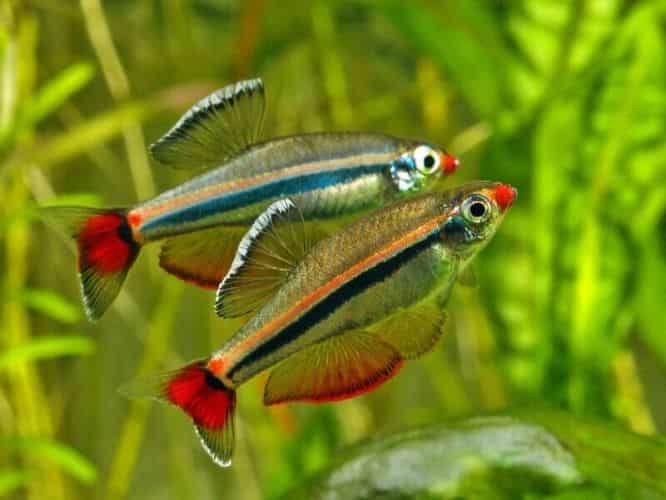
White cloud minnows (Tanichthys Albonubes) are a cool water fish that can tolerate tropical water temperatures. They are native to China, where they inhabit cool river areas.
White Cloud Minnows are almost extinct in the wild due to pollution and encroachment of their environment by humans.
White cloud minnows grow to about 1.5 inches at maturity. You’ll want to place at least six individuals in your tank. The minimum tank size for six white cloud minnows is about about ten gallons if no other fish are present. Their preferred water temperature is 64 To 79°F. Their preferred pH is 6.0 to 7.5.
Temperament: White cloud minnows are friendly and peaceful.
Life Span: White cloud minnows will live about five years.
Feeding: These species are omnivorous, which means they will eat both plant and animal material.
Breeding: It is easy to breed white cloud minnows. To breed white cloud minnows them feed them high nutrition live food such as daphnia and brine shrimp.
White clouds are egg scatterers; they drop their eggs freely among the vegetation and gravel. The eggs will hatch within two or three days. White cloud minnows do not cannibalize their eggs. Because of this, adults can be left in the breeding tank after spawning.
Colors and types: White Cloud minnows are available in gold and grey colors. They have red fins and red tails. Meter Minnow and the Golden cloud are two main variations of white cloud minnows.
Availability: Usually but not always available where aquarium fish are sold.
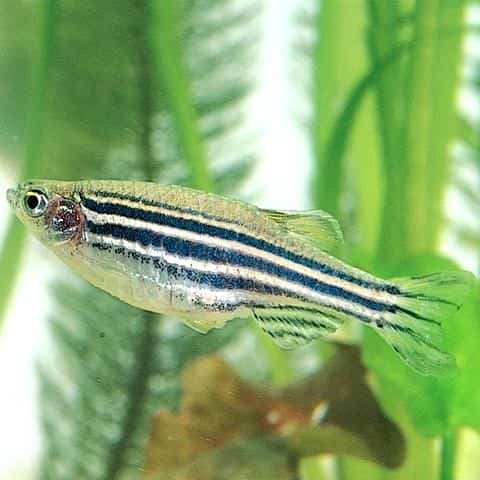
Zebra Danio
Image provided by Carolina Biological Supply Company an Amazon seller.
You can view their popular store and buy this fish by tapping here.
The zebra danio (Danio Rerio) is an exciting, active member of any community aquarium. They are easy to care for and perfect for a beginner’s aquarium.
Zebra Danios are native to South Asia. They inhabit ditches, canals, streams, ponds, lakes, and rice paddies.
Zebra danios grow to about 1.5 inches. Their preferred water temperature is 65 to 75°F. The preferred water pH for the zebra danio is between 7.0 to 8.0.
Temperament: Zebra danios are peaceful, community fish.
Life span: A Zebra Danio will live two to three years.
Feeding: Zebra danios are omnivorous, and they thrive on typical fish food, including flakes, tablets, live foods, and frozen foods.
Breeding: Breeding of zebra danios is very easy. When given clean water and an abundance of highly nutritious foods, they will scatter eggs throughout the breeding tank. You’ll want to remove the parents from the breeding tank as they will eat the eggs. The eggs will hatch in two days.
Colors and types: Zebra Danios have long dark and white stripes on their sides.
Availability: Readily available where aquarium fish are sold.
Bettas (Betta Splendens) are an easy, fun freshwater beginners fish to keep. They act tough when you get near their tank. They’ll flare their fins and gills as an instinct to scare you away.
They can be stunning, as you can see in this Bing images link or the pictures featured here.
Bettas are also known as the siamese fighting fish, although you don’t hear that name much anymore.
They are native to South Asia.
I wouldn’t put a Betta in any tank less than 5 gallons. Water movement in their tank should be gentle. The preferred water temperature for the Betta fish is 72 to 82°F and a suggested pH of 6.8 to 7.4.
Temperament: Betta fish do well in a community tank. Other fish may nip at the Betta’s fins, so be on the lookout for that problem.
Don’t keep other Bettas, male or female, with your Betta because they will fight, which will eventually kill one of them.
Life Span: The average lifespan of the Betta fish is three years, but they can live longer.
Feeding: Betta fish are insectivores meaning they do best of fed “live,” “insect-like” foods like bloodworms, brine shrimp, Daphnia, and other frozen foods. Being opportunistic feeders, they will eat flake food if it is available.
Breeding: Breeding Bettas is pretty straightforward, if not easy. Get the female ready to lay eggs by feeding her larger than normal portions of high-quality foods. When a male Betta is ready to reproduce, he will use his mouth to build a large nest of bubbles on the surface of the water. When it seems the nest is as big as he’s going to make it, release the female into the tank. When spawning seems complete, remove the female Betta. Eggs will hatch in two or three days. Remove the male at this time and feed the fry food appropriate for baby fish.
Colors and types: Betta fish are available in various colors such as black, white, pink, green, blue, red, purple, and yellow.
Availability: Readily available where aquarium fish are sold.
Easy Fish #16. African Cichlids
various
Ease care: very easy
African cichlids are native to three large lakes in East Africa. Choosing an African cichlid fish might be challenging because there are so many choices.
These colorful fish are easy to care for and even thrive in hard water. Beginners will rarely make enough mistakes to kill an African cichlid. They are active swimmers, and their breeding habits are fascinating to watch.
You’ll pay about $5 to $10 for each fish in your local pet store.
The minimum tank size required for the African Cichlid is 30 gallons. Don’t overstock your aquarium! The preferred water temperature is 73 to 82°F with a pH of 7.8 to 8.5, which is fairly high. If you come from an area with soft water, you will need to add a substrate to raise the pH.
Temperament: African cichlids can be aggressive and territorial when spawning or caring for their young. Most African cichlids are “mouthbrooders,” meaning they keep their eggs in their mouths until they hatch. The fry will return to the parent’s mouths if they sense danger.
Lifespan: African cichlids will live from five to fifteen years.
Feeding: African cichlids will eat anything you put in their tank, from flakes to tablets and frozen foods to live foods.
Breeding: African cichlids are mouthbrooders. The male cichlid will dig out a cave or take over a cave. He will then use the cave to entice the female to breed with him. Female cichlid lay eggs in the cave, and then after the male cichlid has fertilized them, she will take the eggs into her mouth. She will keep the eggs in her mouth until they hatch in 21 days.
Colors and types: African cichlids are available in various color combinations such as orange, yellow, purple, red, pink, blue, and black.

Young Harlequin Rasbora
Image provided by WorldwideTropicals <-visit their Amazon store by tapping here.
Buy Harlequin Rasboras frrom Woldwide Tropicals by tapping this sentence.
Harlequin Rasbora
Image provided by Ornamental Aquatics <-visit their eBay store by tapping here.
Buy Harlequin Rasboras frrom Ornamental Aquatics by tapping this sentence.
Rasboras (Trigonostigma Heteromorpha) or Harlequin Rasboras are good starter fish for beginners.
They have great colors, and they school tightly. They are curious and gentle. Rasboras grow to about one and a half inches in length.
Rasboras are native to Southeast Asia and China.
The suggested tank size for a good-sized school of Rasboras is a lightly stocked 30-gallon aquarium. They prefer the company of other Rasboras so buy at least 6 to place in your tank.
They like tropical water temperatures. In the wild, Rasboras inhabit very soft water, so they prefer softer water that is not more than medium hardness.
Lifespan: The lifespan of the rasbora is 5 to 8 years.
Feeding: Rasboras are opportunistic feeders and are willing to eat either protein or vegetable-based fish foods.
Breeding: It is a little challenging to breed rasbora, but it’s not impossible. The breeding tank water should be soft. You must keep two females for each male. Keep a lot of plants in your breeding tank. When they are ready to spawn, rasbora female signals the male by taking up a position near a chosen leaf. The female will lay eggs on the underside of the leaf, which the male then fertilizes. Remove the parents at this point, or they will eat the eggs. Eggs will hatch within 18 to 24 hours.
Colors and types: Rasboras are Reddish tan with black coloring along the back half of the fish.
Availability: Rasboras are readily available where aquarium fish are sold.
Pictus Catfish
Pictus catfish (Pimelodus Pictus) are attractive and non-teritorial. They are active and exciting to watch as they swim at the bottom of the aquarium searching for food.
They are native to the Orinoco and Amazon river basins in South America.
Water conditions: Their prefer soft water that is around 75° F to 81° F.
Growth: Pictus cats grow to be about 4 to 5 inches in length.
Aquarium size: The tank size recommended for the pictus catfish is 30, lightly stocked gallons.
Temperament: Temperament of pictus catfish is peaceful although they will try to eat fish smaller than themselves.
Lifespan: Pictus catfish live about 6 years.
Feeding: Pictus catfish are omnivores. They can be fed algae tablets, small fish, insects, blood worms, daphnia and brine shrimp.
Breeding: Pictus fish are a typical egg-laying fish, but difficult to breed in captivity. It is unlikely that they will breed in a home aquarium.
Colors: Pictus catfish is a silver color with the black spots. They have white barbels (whiskers) and transparent fins.
Availability: Pictus catfish are readily available where aquarium fish are sold.
Easy Fish #19. Dwarf Gourami
Ease care: very easy
“Honey” Dwarf Gourami
Image provided by Aquatic Heavens, an Amazon Store.
Tap picture to price or buy a Honey Gourami.
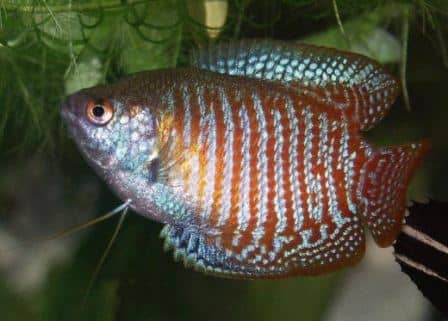
Dwarf gourami – blue with red stripes – Photo: Quatermass. Released to Public Domain. Available: https://commons.wikimedia.org/wiki/File:Colisa_lalia.jpg.
Dwarf gourami (Trichogaster Lalius) is a colorful and peaceful fish. They are easy to care for (I.E. hard to kill) and stay relatively small (3.5 inches) so they make a good addition to a freshwater, community tank.
Dwarf gouramis are native to South Asia, mainly Bangladesh, India, and Pakistan.
The dwarf gourami is a labyrinth fish. This means that they have a special organ that allows them to breathe air.
Dwarf gouramis inhabit slow running waters in rivers, lakes, and streams.
You really don’t want to get just one dwarf gourami so allow at least 10 gallons of sparsely stocked tank space for each dwarf gourami you buy.
They like tropical water temperatures but can tolerate slightly higher than average temperatures. This heat tolerance could make them a good addition for a discus tank. They are fairly tolerant of different pH levels.
Lifespan: Dwarf gouramis will live 4 to 5 years.
Feeding: Dwarf gouramis are omnivores. In the wild they feed on small invertebrates, algae, and other plant matter. You can offer them high-quality live and frozen foods, flakes, tablets, and canned or cooked vegetables.
Breeding: Dwarf gouramis are best bred in a separate breeding tank with the parents being removed after spawning. This is because they will eat the eggs given a chance.
Colors and types: They come in honey color with red vertical, dotted stripes and blue fins. They are also available in red, blue/red, white and blue with irregular dot patterns.
Easy Fish #20. Tiger Barbs
Ease care: easy
Tiger Barb
Image provided by Aquarium Plants Discounts, an Amazon store. To price or buy Tiger Barbs, tap the image.
Tiger Barbs (Puntigrus tetrazona) is a colorful and peaceful fish. They are easy to care for (I.E. hard to kill) and stay relatively small (2.5 inches) so they make an OK addition to a freshwater, community tank.
I have five Tiger Barbs in my community tank. They are about 2 years old and about 2 “chunky) inches in length.
They are a bit agressive and will nip at other fishes fins. They love ramshorn snails so if you have a lot those snails you won’t for long.
They are a little shy, but if you add so other fish in that are not shy they will come out to greet you. I have a few molly fish.
Dwarf gouramis are native to Southeast Asia (Cambodia and Indonesia.
According to Wikipedia they are fairly open to water conditions that other tropical fish
They prefer to school so consider buying 10 or more for your lightly stocked 55 gallon aquarium.
“Unleash Your Inner Oscar Fish Expert: Learn the Ins and Outs of Care, Keeping, Feeding, and Breeding!”
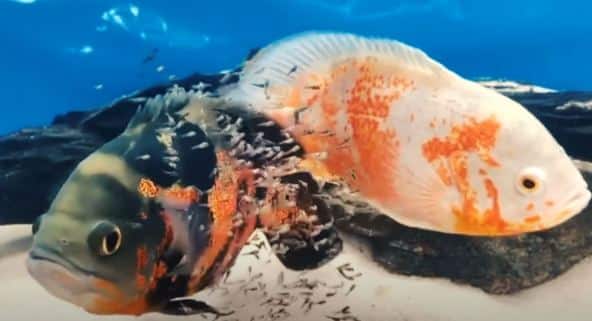
Pictured above: Mated oscar pair with fry (swimming around the tiger oscar).
